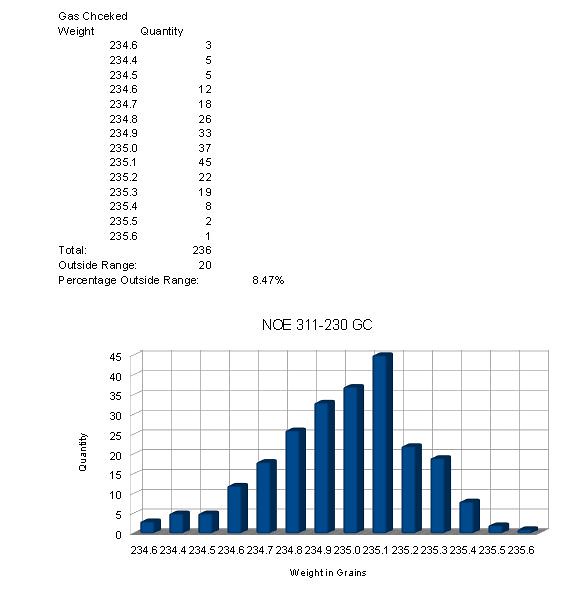I have cast handgun boolits for a long time, but did not do much with rifle boolits till I read a lot in this forum. Seems rifles can be just as accurate with lead as with copper when done right. But the question keeps coming up. What is "done right."
With handgun boolits mostly for practice a grain one way or the other doesn't seem to make much difference. With rifles, I'm not so sure. Took a long time to get the hang of them little bitty critters in the first place. A 45 is pretty easy. A 30 caliber boolit is a horse of a different shoe size.
But once they are coming out of the mold the way they should, how much variance in weight is acceptable before it really begins to make a difference at 100 yards?
Sat down and weighed some commercial 45 boolits. Just grabbed a few from a maker that sold by the box of 100 and they ranged between 184.3 to 185.3 for their 185 gr. 45 ACP cast boolit. Another that sold by the box of 500 for a 200 gr.45 ACP ranged from 193.1 to 197.5. Didn't weigh them all but none I found actually weighed 200 gr.
Then I got out a few j-word projectiles and one .30 cal 180 gr. box weighed from 179.6 to 180.9
Another 200 gr. 30gr. 30 cal ran 199.2 to 201.5
Finally tried a few of the solid copper gizmos and for 200 gr. in 30 cal I found 199.8 to 200.5
in 180 gr. 30 cal solid copper I found the best running from 180 to 180.3
So, in the 45 handgun mass casting boolits there was a 1gr difference in on brand and a 4.4 gr difference in the other
In commercial j-word projectiles there was a 1.3 to a 2.3 gr difference
In commercial solid brass there was an allowance of .7 in one and .3 in the other.
I have always tried to stay within .5 gr plus or minus for a 1 grain total difference between boolits, thinking that was a fair variance in casting
Now I'm undecided. In handguns cast by someone else I found as much as a 4.4gr. difference in boolits, and in commercial j-word slugs I found a 1.3 and a 2.3 difference in projectiles in the same box.
I was surprised to find that even solid copper commercial slugs ran from .7 to .3 difference in a box.
So, if you are shooting for accuracy in a rifle, how much difference in boolit weight is acceptable?
I'll stick with my plus or minus .5 gr in handgun rounds. (199.5 to 200.5 as an example) Haven't seen anything to tell me that there is much of a difference out to 50 yards using that criteria but am certainly willing to listen to any ideas.
Guess the bottom line is I just have not got good enough at casting to keep the weight of each boolit the same or even close to the same. Some times I have three different groups from one casting session ( 198.5 plus or minus .5, then 199.5 plus or minus .5, then 200.5 plus or minus .5) if that makes sense.
Am I just being too picky and need to lighten up, or is there a real difference in how much the boolit weights when you start reaching past 100 yards?
Can someone educate me as to how much weight difference is acceptable?

|
   
   
|


|



 Reply With Quote
Reply With Quote





























